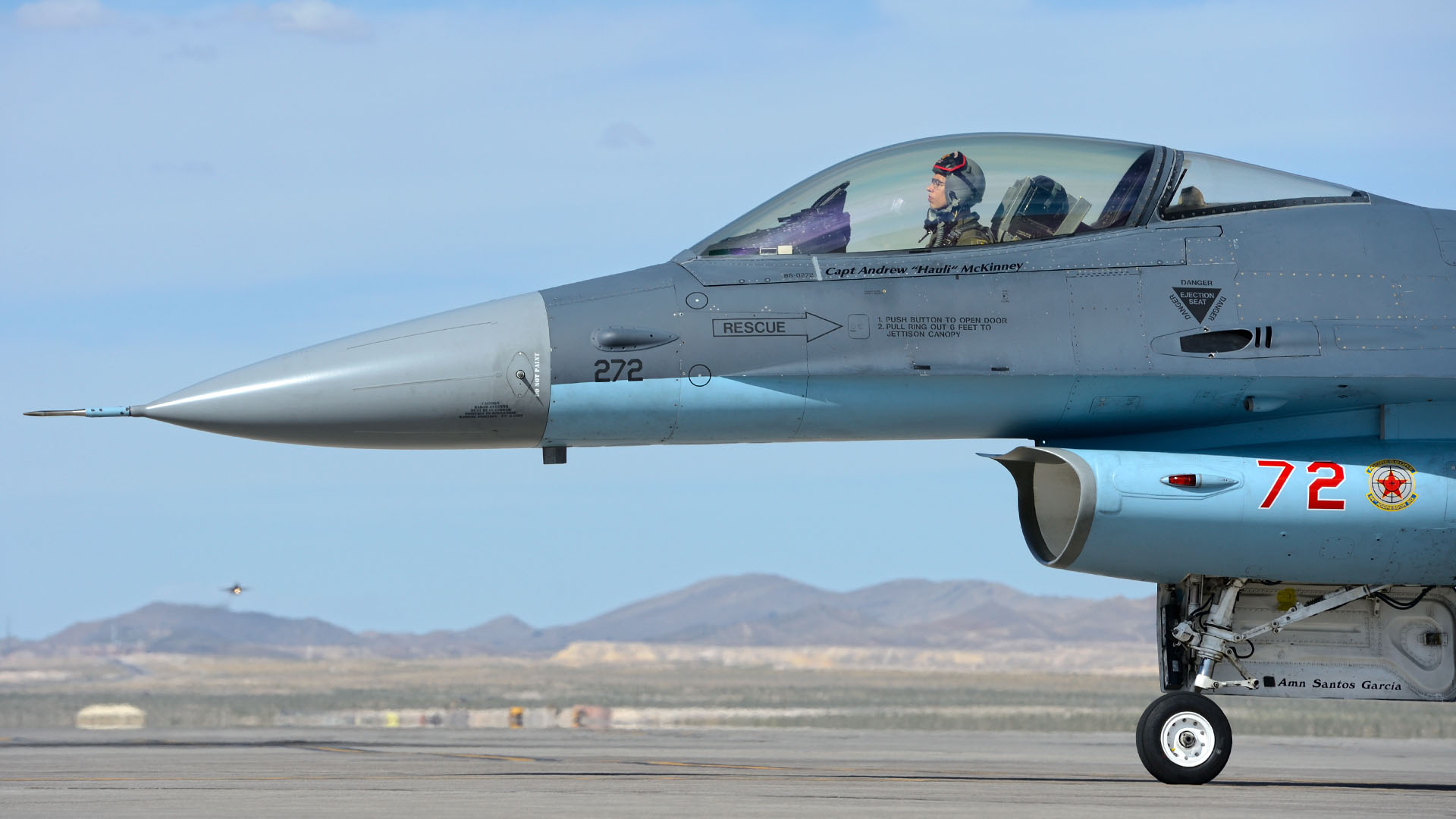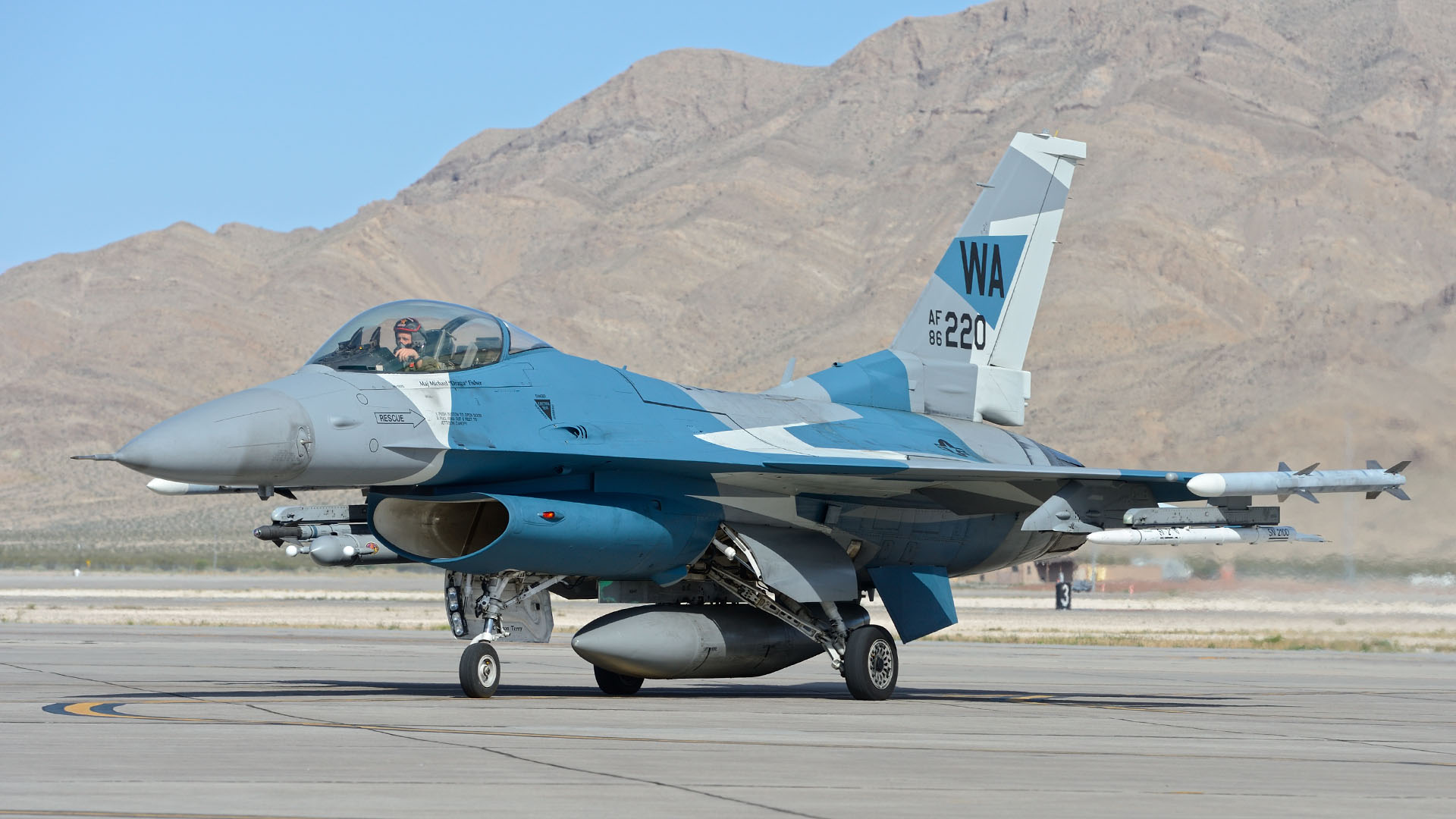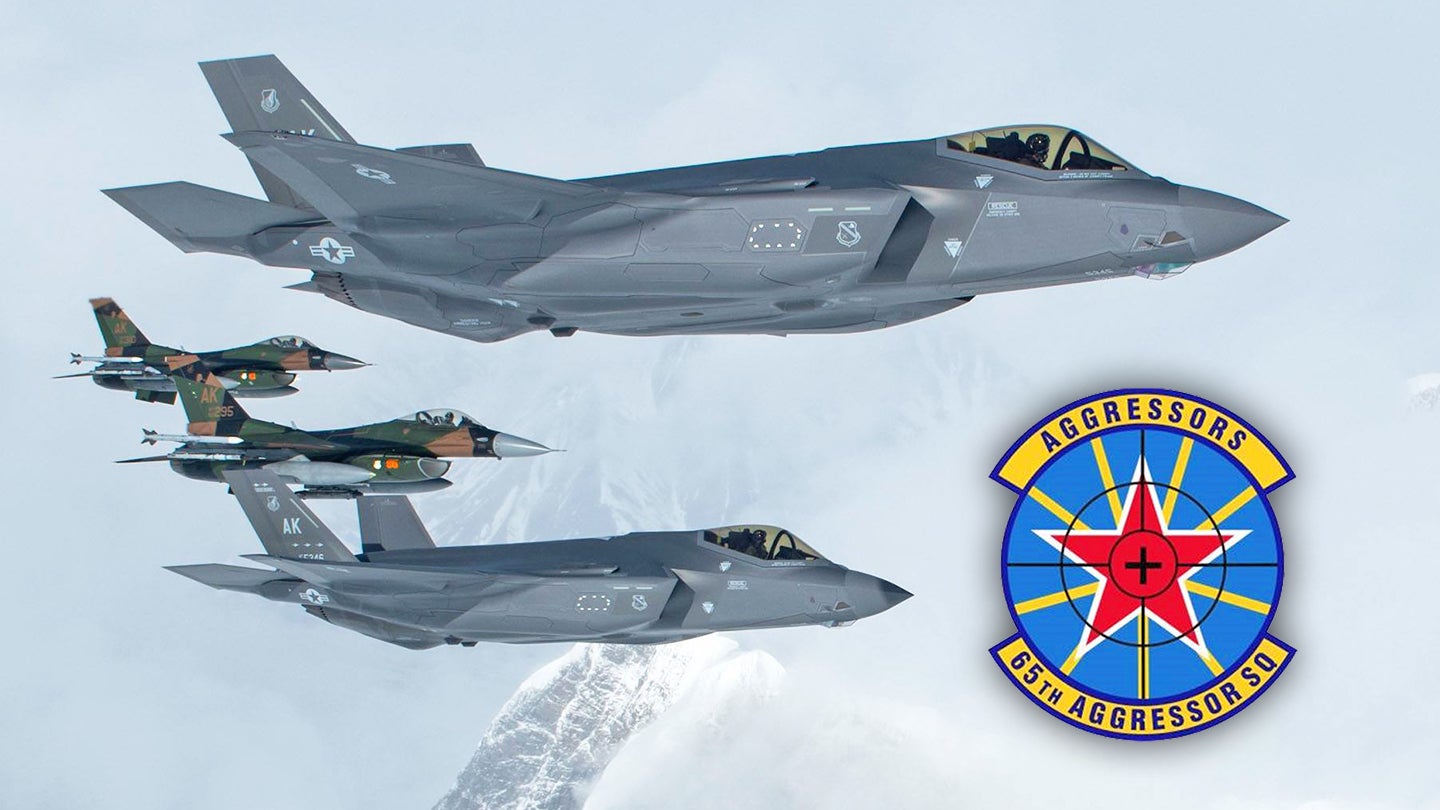The U.S. Air Force is moving forward with plans to field an increased fleet of high-end aggressor aircraft at Nellis Air Force Base, Nevada. It plans to re-activate the 65th Aggressor Squadron (AGRS) next year to complement the existing 64th AGRS, which traditionally flies Block 25/32 F-16Cs. The additional unit is planned to fly a mix of more advanced Block 42 F-16C/D Vipers, as well as early block F-35A stealth fighters. This confirms USAF plans announced in 2019 to draft a batch of its earliest Lightning IIs into the aggressor role.
“The goal for the aggressors has always been where we are essentially matching the aggressiveness of our global competitors,” explains Lt Col Jan “Kuts” Stahl, an experienced aggressor pilot and deputy commander of the 57th Operations Group. “They are fielding technology at a rapid pace, and our goal has always been to match, and if possible exceed, that level of technological advancement. So, the threat that we are preparing the warfighter for locally exceeds anything that they’re ever likely to face in battle.”
The Nellis aggressor forces are heavily engaged with presenting realistic threats to aircrews in order to better prepare them for combat. The new set-up will far better enable the USAF to train “Blue Force” aviators on how to face the most modern enemy threats.
The reactivated 65th Aggressor Squadron will likely field up to a dozen F-35s, with their advanced software tailored to help accurately mimic specific advanced airborne threats. Combined with the skill of the aggressor pilots, it will represent a potent force with which to train both the latest Weapons School students, as well as aircrews visiting Nellis for high-end exercises, such as Red Flag. It will also help to properly tax the operational test community as it evaluates the latest combat air forces capabilities and tactics.

In parallel with the addition of F-35s, internal USAF reorganization has resulted in a decision to close down the 24th Tactical Air Support Squadron [TASS], that flies Vipers at Nellis. The unit is currently a centralized location for training F-16 Close Air Support (CAS) instructors and for retaining a dedicated close air support knowledge base. This was conceived partially to help mitigate the possible retirement of the A-10 Thunderbolt II. You can read more about this arrangement in this past War Zone piece. However, with the A-10 now remaining in service and even getting major upgrades, the 24th TASS role is being dispersed to other units, which has presented an important opportunity to use these F-16s to plus-up the Nellis aggressors. “We currently have 19 pre-Block F-16s [Block 25 and 32] and the game plan is to take over an additional 11 Block 42 F-16s,” says Stahl.
“Initially, when the 24th TASS shuts down, the 64th AGRS is going to become a very large squadron, but there are efforts underway to reactivate the 65th AGRS — around the summer of 2021 — when we split those assets into two units to make them a bit more manageable,” Stahl explains.
On January 12, 2006, Lt Col Larry “Bo” Bruce took command of the 65th AGRS as it reformed at Nellis with F-15C/D Eagles, as part of a dramatic expansion of resident aggressor forces. However, extreme budget pressures led to the unit being axed in 2014 as part of an overall force reduction in the wake of sequestration. A handful of F-15C/Ds were initially retained under the 64th AGRS, but these were eventually dispersed to other units.
“Nellis needed aggressors more than ever at that time,” says Lt Col Stahl. “As a matter of fact, the F-35 footprint here at Nellis was just beginning to get spun up at that point, as well. We were going to need more aggressors, not less. The aggressors that we did have needed that next level of capability in order to provide a challenging sparring partner to the fifth-generation fighter pilots.” Stahl says that closing down the aggressor Eagle squadron was unavoidable at the time, but that it was a decision “we are now having to deal with the after-effects of.”

“The combined fielded aggressor forces we have here at Nellis [today] is barely able to fill 70 or so percent of our optimal demand for adversary forces. That’s what led the air force to look at alternative courses of action, such as contract aggressors, as well as inviting visiting units from elsewhere to come and help us out. Because of the demands that were put on the adversaries here at Nellis, it was clear from the get-go that we weren’t going to be able to shut down a unit like the 65th and immediately replace it with something equivalent. The fielding of contract aggressor forces was always intended to be a multi-year process in which initially we put jets on the line to fill more of the demand for quantity as opposed to the demand for quality,” Stahl explains.
While contract adversaries have taken some of the strain off the air force’s organic aggressor force, Stahl says that the organization is looking to stimulate companies to gradually build up to a point where they’re financially and operationally able to field airframes of higher capability. This will work in tandem with the upscaling of in-house resources.
The 2018 National Defense Strategy (NDS) directly highlighted a need to address near-peer threats. Concerns have been leveled that the USAF is losing ground in the technology battle; with a need to focus on high-end warfare, which has been eroded due to relentless combat deployments focused on counter-insurgency operations that have been such a taxing demand for squadrons.
The 64th AGRS will likely retain the earlier Block 25/32 aircraft, with the Block 42s flowing over to the 65th AGRS as that unit is reactivated. “That’s when it gets really interesting, because that’s when the early block F-35s start arriving here at Nellis and moving into the 65th AGRS, which then becomes a mixed F-35 and F-16 aggressor squadron,” Stahl adds. He says that plans are still in a state of flux, but the Nellis aggressor community expects to see the first F-35s for the mission arriving at the Nevada base sometime in the spring.

Alongside the F-35s, the introduction of Block 42 F-16 Vipers will bring additional benefits for the aggressors. Their Link 16 data links will be an early boost for the USAF aggressors at Nellis. Some of the current F-16s with the 64th AGRS carry the SADL (Situational Awareness Data Link), which serves as an intra-flight link between the aggressors. Link 16 will enable the new 65th AGRS adversaries to make use of a full battlespace picture, and operate more independently as a coordinated team, instead of a more traditional approach of working with Ground Controlled Intercept (GCI) controllers at Nellis. It’s also worth noting that the F-35A has full link 16 capability, so it can receive information from the Vipers while remaining fully stealthy and it can share information, as well, with a bit more risk of being detected.
The Block 42 F-16 avionics architecture is also more readily able to support the fielding of new systems, such as the Angry Kitten pod, that was recently adopted by the 64th AGRS. This pod incorporates advanced radio frequency (RF) jamming technology that can counter increasingly sophisticated electronic warfare threats. The Operational Flight Program (OFP) in the later block F-16s is more frequently updated and readily able to accept enhancements that can help keep the aggressors relevant.
An Active Electronically Scanned Array (AESA) radar is another capability that the aggressor F-16s would benefit from, as increasing numbers of threat aircraft have these advanced sensors. The USAF is already fielding new Northrop Grumman AN/APG-83 AESA radars in its F-16 fleet, and Stahl says for the aggressors; “it’s a capability that has to happen sooner or later.”
Instead of targeting fleetwide capabilities, the aggressors are able to dip into new areas of technology to add small niche capabilities to help them replicate specific real-world threats. One of the 64th AGRS F-16s flew with a pod very similar to the Legion infrared search and track (IRST) pod in 2013, and Stahl says experimental work has also been undertaken with Litening and Sniper targeting pods to simulate IRST capability. “Fielding early F-35s will help us close that technology gap as well.”

The previous 57th Wing commander at Nellis AFB, Brig Gen Robert Novotny, first broke news of a possible aggressor mission for early batch F-35s in 2019. It was subsequently detailed that this would likely include some of the air force’s earliest Lightnings, which would be transferred from a training role with the 33rd Fighter Wing at Eglin Air Force Base, Florida. The F-35 will transform the USAF aggressors, which have in recent years relied on some of the oldest F-16s in the inventory to provide high-end threat replication.
The “mass” of contract aggressors, which are currently providing a quantity of “Red Air” to support the Nellis aggressors, is now being combined with a steady increase in capability to provide high-end threat replication like never before seen. The addition of both Block 42 F-16s and F-35s will see a transformational leap in the training offered by the Nellis aggressors.
With all this in mind, reforming the 65th Aggressor Squadron next year will arguably signal the biggest advance in USAF combat training since 2005. Pressing the F-35 into the adversary role will keep Nellis at the forefront of USAF training, and will cement its position as “The Home Of The Fighter Pilot.”
A full version of The War Zone’s fascinating interview with Lt Col Stahl will be published soon.
Contact the editor: Tyler@thedrive.com
